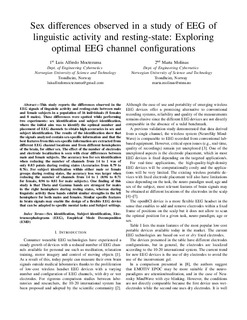| dc.contributor.author | Moctezuma, Luis Alfredo | |
| dc.contributor.author | Molinas Cabrera, Maria Marta | |
| dc.date.accessioned | 2020-01-27T13:45:26Z | |
| dc.date.available | 2020-01-27T13:45:26Z | |
| dc.date.created | 2019-09-29T15:48:07Z | |
| dc.date.issued | 2019 | |
| dc.identifier.isbn | 978-1-5386-8116-9 | |
| dc.identifier.uri | http://hdl.handle.net/11250/2638114 | |
| dc.description.abstract | This study reports the differences observed in theEEG signals of linguistic activity and resting-state between maleand female subjects in a population of 16 individuals (8 femalesand 8 males). These differences were spotted while performingtwo experiments: sex identification and subject identification,where the initial aim was to identify the optimal number andplacement of EEG channels to obtain high accuracies in sex andsubject identification. The results of the identification show thatthe signals analyzed contain sex-specific information and that thebest features from this sex-specific information are extracted fromdifferent EEG channel locations and from different hemispheresof the brain, for either sex. The effect of the number of electrodesand electrode localization is seen with clear differences betweenmale and female subjects. The accuracy loss for sex identificationwhen reducing the number of channels from 14 to 1 was ofonly 0.03 points during resting states (Accuracies from 0.79 to0.76). For subject identification within either male or femalegroups during resting states, the accuracy loss was larger whenreducing the number of channels from 14 to 1 (0.96 to 0.71for female, 0.96 to 0.81 for male subjects). One finding of thisstudy is that Theta and Gamma bands are strongest for malesin the right hemisphere during resting states, whereas duringlinguistic activity these bands exhibit similar strengths in the lefthemisphere for both males and females. Similar specific featuresin brain signals may enable the design of a flexible EEG devicethat can be adapted to specific mental tasks and Subject settings | nb_NO |
| dc.language.iso | eng | nb_NO |
| dc.publisher | IEEE | nb_NO |
| dc.relation.ispartof | 2019 7th International Winter Conference on Brain-Computer Interface (BCI) | |
| dc.title | Sex differences observed in a study of EEG of linguistic activity and resting-state: Exploring optimal EEG channel configurations | nb_NO |
| dc.type | Chapter | nb_NO |
| dc.type | Peer reviewed | nb_NO |
| dc.description.version | acceptedVersion | nb_NO |
| dc.identifier.cristin | 1730850 | |
| dc.description.localcode | © 2019 IEEE. Personal use of this material is permitted. Permission from IEEE must be obtained for all other uses, in any current or future media, including reprinting/republishing this material for advertising or promotional purposes, creating new collective works, for resale or redistribution to servers or lists, or reuse of any copyrighted component of this work in other works. ISBN 978-1-5386-8116-9 | nb_NO |
| cristin.unitcode | 194,63,25,0 | |
| cristin.unitname | Institutt for teknisk kybernetikk | |
| cristin.ispublished | true | |
| cristin.fulltext | postprint | |
| cristin.qualitycode | 1 | |
